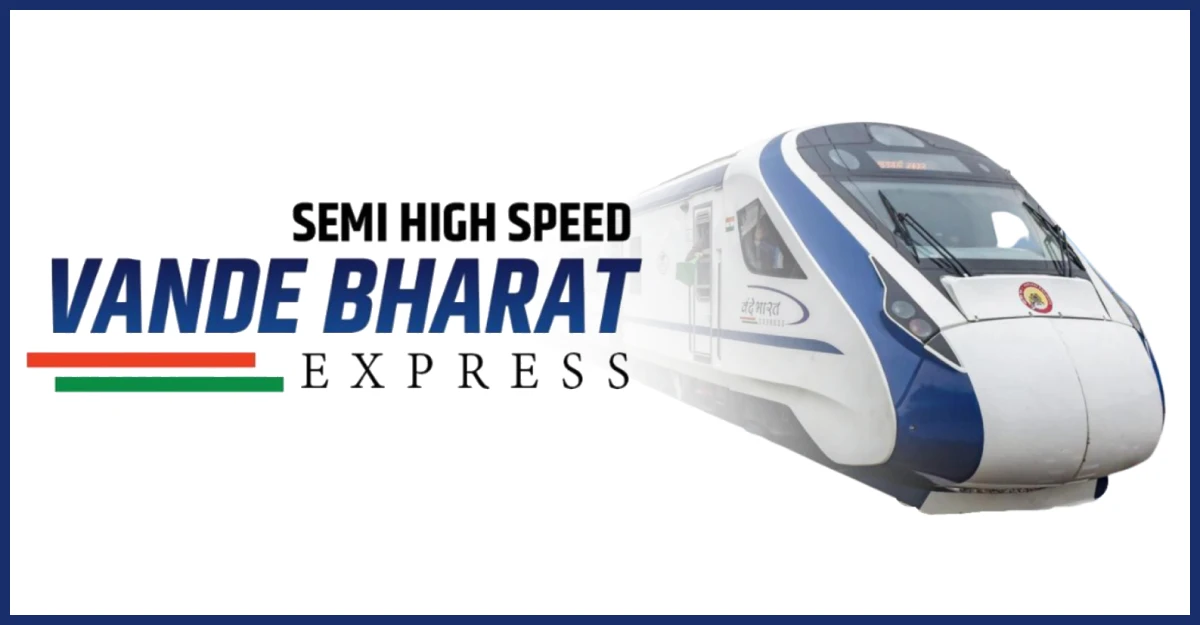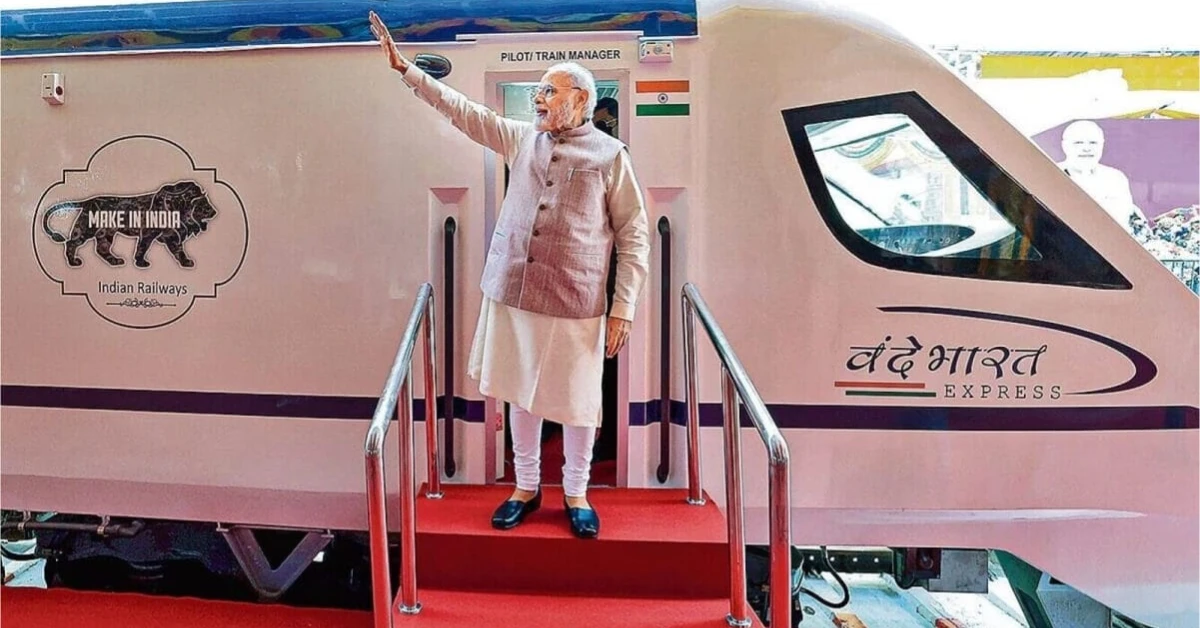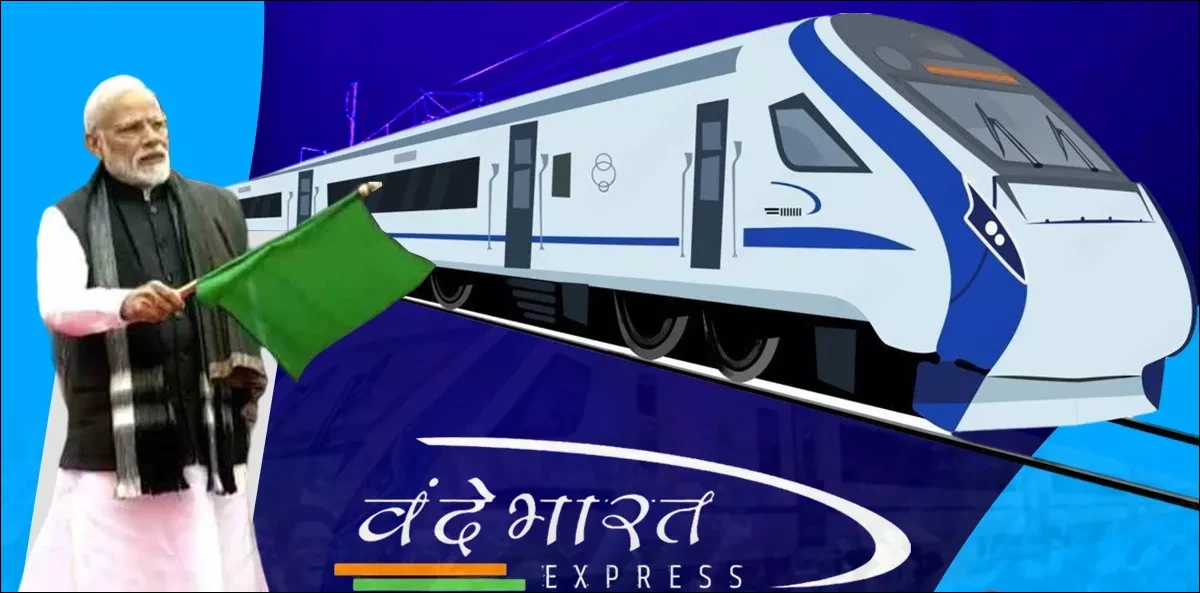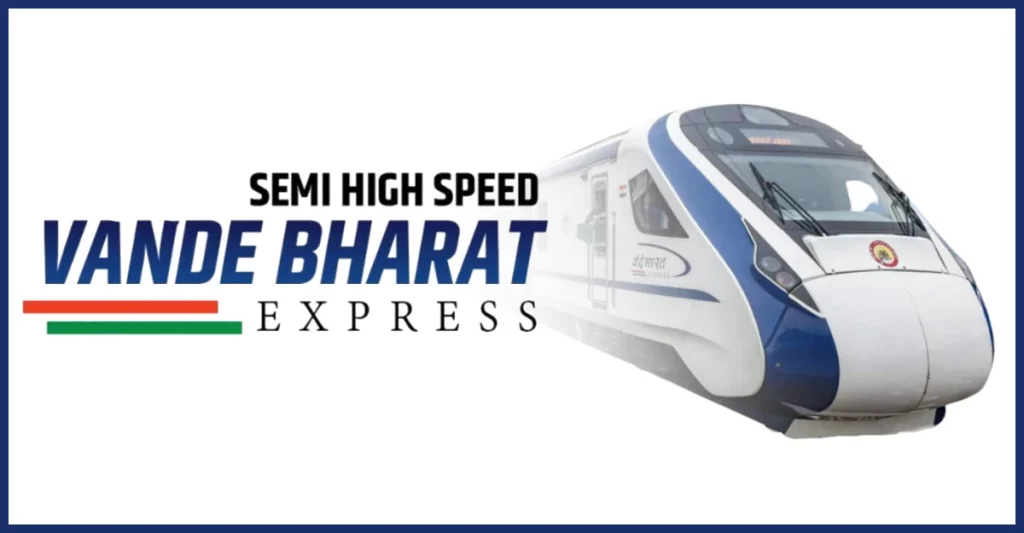If you have been residing in India for the last five years, I’m sure you have heard the term “Vande Bharat.” Afterall, Vande Bharat Train isn’t just a rail transport but a testament to a pride in India’s railway legacy.

Launched with a dream to transform how we travel, this high-speed marvel seamlessly blends innovation and efficiency.
How? You may ask.
From its sleek aerodynamic design to cutting-edge features, the Vande Bharat train is rewriting the story of rail travel.
All these praises boil down to one question- What’s special about the Vande Bharat train?
Are you curious to get an answer to this question? If yes, then join us in this exploration, as we uncover its unique attributes, delving into the advanced technology, onboard facilities, and the profound impact it’s making on Indian railways.
Let’s begin!
(A) What is Vande Bharat Train?
The Vande Bharat train is a high-speed train service operated by Indian Railways. Ever hopped on it? This superfast express operates as a medium-distance train service under Indian Railways, resembling the Shatabdi Express.
Ever wondered why and how it obtained such a legendary name i.e. “Vande Bharat.” Well, it is named to acknowledge the fact that it was entirely built in India by our engineers.
Yeah!
This supreme technology isn’t imported, rather built indigenously.
Indians often complain about the rail services. Delayed trains, train cancellation, long waiting lists, etc. aren’t alien concepts for us. Hence, Indian Railways prepared a big feast for us through the Vande Bharat train. It planned to cut travel time between cities less than 10 hours apart.
For instance, the Delhi-Bhopal service has a capped speed of 160 km/h, while other routes operate between 110–130 km/h.
Notably, zipping at semi-high speeds, hitting 183 km/h during trials – that’s faster than the certified 160 km/h! And here’s the kicker – the train’s rapid acceleration and deceleration allow it to go from 0 to 100 km/h in a mere 52 seconds during trials.
Impressive, right?
That’s not all!
Originally called Train 18, it was crafted by the RDSO (Research Designs and Standards Organization) and made by the ICF (Integral Coach Factory). They designed it for cost-effective maintenance and top-notch operations.
The price tag for a 16-coach Vande Bharat train?
About ₹115 crore (US$14 million).
Now, that’s a ticket to speedy, efficient rail travel!
| Train’s Name | Vande Bharat Train |
| Service Type | Inter-city semi-high-speed rail |
| Status | Active |
| Predecessor | Shatabdi Express, Jan Shatabdi Express, MEMU |
| First Service | 15th February, 2019 |
| Lines used (Route) | 34 |
| Operational Status | Vande-Bharat train services are operational on Indian Railways, connecting states with the Board Gauge electrified network. |
| Hallmarks | High speed, enhanced safety standards, and world-class service |
| Seating Configuration | 16 air-conditioned coaches, including two executive class coaches. |
| Total Seating Capacity | 1,128 passengers |
| Total Funds Utilised for Manufacturing | Rs.1343.72 Crores. |
(B) Vande Bharat Train: A Brief Overview
Vande Bharat Express, also recognized as Train 18, stands out as a homegrown creation in the domain of train design. Undoubtedly, it signifies a new era in travel technology for Indian Railways. Packed with distinctive features such as bio-vacuum toilets, onboard Wi-Fi, and fully automatic doors, it represents a noteworthy leap in innovation.
This semi-high-speed train commenced operations in mid-February 2019, shuttling between Delhi and Varanasi in approximately 8 hours. Notably, it only makes two stops during the journey – one in Kanpur and the other in Prayagraj.
Interestingly, the estimated cost of this semi-high-speed marvel is Rs.115 crores, and it boasts a swifter pace compared to the Shatabdi Express.
Let’s have a look at its on-board services-
| Aspects of On-Board Services | Details |
| Class(es) | CC Chair (Economy Class), Executive Chair (Premium Class) |
| Seating Arrangements | Airline Style, Rotatable Seats |
| Catering Facilities | On-board Catering |
| Observation Facilities | Large Windows in all Carriages |
| Entertainment Facilities | On-board WiFi, Infotainment System, Electric Outlets, Reading Light |
| Baggage Facilities | Overhead Racks |
| Other Facilities | Automatic Doors, Smoke Alarms, CCTV Cameras, Odour Control System, Bio-Vacuum Toilets, Sensor-based Water Taps, Roller Blinds |
Now, let’s go through the technical aspects of Vande Bharat train-
| Technical Aspects | Details |
| Rolling Stock | Vande Bharat (Trainset) |
| Track Gauge | Indian Broad Gauge 1,676 mm (5 ft 6 in) |
| Electrification | 25kV 50 Hz AC Overhead line |
| Operating Speed | 160 km/h (99 mph) in a part of Rani Kamalapati (in Bhopal)- Hazrat Nizmuddin (in Delhi) Route, 110-130 km/h (68-81 mph) in other routes |
| Average Length | 384 m (1,260 ft)- 16 Coaches 192 m (630 ft)- 8 Coaches |
| Top Speed | 180 kmph, covering 1,300 kilometers in 8 hours |
Thus, you can say that the Vande Bharat Express isn’t just a train; it’s a testament to indigenous excellence in the world of rail travel.
(C) When did Vande Bharat Train start?

The Vande Bharat Express, once known as Train 18, kicked off its cool journey on February 15, 2019. But that’s not all – more of these snazzy trains have joined the party!
The newest member?
Launched on June 27, 2023, it’s zipping between Patna and Ranchi, making travel way more exciting.
Here’s the scoop: these electric multiple unit chair car trains are like the top-notch innovation of Indian Railways, designed and crafted right here.
And guess what?
They’re not just sticking to one route – they’re expanding and taking their breathtaking operations to more places.
Oh, and did I mention another astonishing fact? On January 27, 2019, the Train 18 sets officially became the Vande Bharat Express with the first service commencing on 15 February 2019?
So, it’s not just a train; it’s a rolling adventure!
(D) Objectives for Launching Vande Bharat Train
Here comes a million dollar question- Why did Indian Railways launch the Vande Bharat train? Go through the table below and you will find out-
| Objectives | Details |
| Boosting Speeds and Comfort | Shift from safety emphasis to enhance speed and comfort. Replacement of ICF with LHB coaches aimed at introducing semi-high-speed services (160–200 km/h) between major cities. |
| Gatimaan Express and Global Interest | Inauguration of Gatimaan Express in 2016, India’s first semi-high-speed service at 160 km/h. Proposals for similar services garnered global interest from Canada, China, France, Germany, Switzerland. Talgo trains’ trials achieved notable speeds. |
| Make in India Initiative | Initiative to develop an indigenous EMU train set due to challenges with foreign proposals. Driven by Make in India, the ‘Train-2018‘ project, later ‘Train 18,‘ featured air-conditioning, plug doors, onboard Wi-Fi, and infotainment. |
| Shatabdi Replacement and Tech Leap | Vande Bharat Express aimed to replace Shatabdi Express, providing fast, modern service for short-distance travel between major cities. Sixteen chair cars, speed of 160 km/h, marked a technological leap. Second-gen train sets developed in 2022. |
| Phasing Out Shatabdi Express | Strategic plan to phase out all Shatabdi Express trains with the introduction of Vande Bharat Express in 2022. Aligns with providing efficient and modern rail services. New train sets entered service on September 30, 2022. |
Now, let’s dive into the details-
(D.1) Boosting Speeds and Comfort
Alright, let’s rewind a bit. In the good ol’ days, Indian Railways was all about safety, and rightly so. But then, someone had this brilliant idea – “Why not add some speed and comfort to the mix?” So, out went the old coaches, in came the safer LHB coaches.
Once safety was somewhat sorted, the focus shifted to speed and comfort. That’s when the Gatimaan Express zoomed onto the scene in 2016, India’s first semi-high-speed service cruising at 160 km/h.
And you know what? That sparked plans for more speedy journeys between major cities.
(D.2) Gatimaan Express and Global Interest
Fast forward to the Gatimaan Express tearing down the tracks in 2016, hitting 160 km/h – quite the showstopper. Inspired by this speed demon, Indian Railways decided to throw a global party. They wanted to make 5000 modern EMU sets, and guess who responded to the invitation?
Canada, China, France, Germany, and Switzerland were all in! Native companies like Medha and BHEL also showed their interests in this golden opportunity.
Spain’s Talgo trains even took a spin from Mumbai to Delhi, clocking an average speed of 117.5 km/h. But here’s the twist – they couldn’t seal the deal directly, and had to go through a tendering process.
And when no one else stepped up, things got a bit tricky.
(D.3) Make in India initiative
So, with foreign plans hitting a speed bump, Indian Railways thought, “Why not build our own EMU train set?” And that’s when they kicked off the ‘Train-2018’ project, later dubbed ‘Train 18.’ These weren’t your average trains; they were the cool kids – fully air-conditioned, automatic plug doors, onboard Wi-Fi, and even a bit of infotainment.
During their trial runs, Train 18 became the Usain Bolt of Indian EMU trains, hitting a whopping 183 km/h.
(D.4) Shatabdi Replacement and Modernization
Now, the Vande Bharat Express wasn’t just here to make an entrance; it had a job – to replace the Shatabdi Express and give us a speedier, modern travel experience. Picture this: sixteen chair cars, a speed of 160 km/h – it was like the rockstar of trains. Sure, there were a few glitches, but they ironed those wrinkles out. Plans to replace all Shatabdi Express trains with these sleek Vande Bharat wonders were in full steam ahead by 2022.
(D.5) Phasing Out Shatabdi Express
Here’s the climax! With the new Vande Bharat Express rolling onto the scene in 2022, the plan is to bid farewell to all those Shatabdi Express trains. The new kids on the block, the second-gen trainsets, officially hit the tracks on September 30, 2022. It’s like saying goodbye to the old guard and ushering in the future of rail travel.
(E) Exclusive Features of Vande Bharat Train
Let’s look at some of the most alluring features of Vande Bharat train-
| Features & Amenities | Description |
| Fitted with KAVACH Technology | Automatic Train Protection (ATP) by automatic application of brakes if the Loco Pilot fails to do so. |
| Faster acceleration | Semi high speed operation up to 160 km per hour |
| Fully Sealed Gangway | For free/unrestricted movement of passengers |
| Automatic Plug Doors | Modern automatic plug doors for convenience |
| Reclining Ergonomic Seats | Comfortable seating with rotating seats in executive class |
| Better Ride Comfort | Mobile charging sockets for every seat, dual mode lighting for general and personal illumination. |
| Special Lavatary | For differently-abled passengers |
| Safety Features | Emergency openable windows, Fire extinguishers in each coach, CCTVs in all Coachers, Emergency Alarm Push buttons, Talk back units on all coaches, Emergency communication facilities, CCMS (Coach Condition Monitoring System) for real-time assessment, Disaster lights (four numbers) in each coach, Rearview Cameras (four platform side cameras), Driver-Guard communication with voice recording facility |
| Powered by self-propulsion module | No need for a locomotive to pull it. |
| Made of Stainless Steel | Lightweight and energy-efficient construction |
| Advanced Features | Bio-vacuum toilets, automatic doors, and GPS-based passenger information systems |
| Spacious and Comfortable Interior | Contrasted with other trains in India |
| Hallmarks of the train | High speed, enhanced safety standards, and world-class service |
All these information was given by the Minister of Railways, Communications and Electronic & Information Technology, Shri Ashwini Vaishnaw in a written reply to a question in Lok Sabha.
(F) Why Vande Bharat Express Doesn’t need locomotive?
The Vande Bharat Express operates without the need for a separate locomotive engine, thanks to its distributed power system. The engine is integrated into its own coach.
Integral Coach Factory’s General Manager, BG Mallya, explains, “In a 16-coach Vande Bharat, we have eight motor coaches, each with a power capacity of 840 KW. For an eight-coach train set, we have nearly 7,000 KW of available power. Despite the absence of a visible locomotive, the Vande Bharat’s power is equivalent to 1.8 or 2 locomotives.”
Union Railway Minister Ashwini Vaishnav highlights, “Vande Bharat is essentially a computer on wheels. Its vehicle control system, power electronics, powertrain, transformers, motor – almost everything is controlled by software.”
(G) Interesting facts about Vande Bharat Train
Let’s delve into some of the interesting facts about Vande Bharat train-
| Interesting Facts | Details |
| Engine Innovation | India’s first engineless train, redefining travel with an integrated engine similar to bullet or metro trains. Faster acceleration promises reduced journey times. |
| Seating Extravaganza | Featuring 16 fully air-conditioned chair cars with two seating options – Economy and Executive class. Executive class chairs can swivel 180 degrees, adding a touch of luxury. |
| Culinary Delights | Complimentary food service with meals included in the ticket price. From breakfast and lunch in New Delhi to Varanasi trips to tea, snacks, and dinner on the return journey. |
| Tech-Savvy Connectivity | Onboard Wi-Fi access for internet services, keeping passengers connected and entertained through mobile devices. |
| GPS Guidance | Equipped with a GPS-based advanced passenger information system, ensuring passengers stay informed about upcoming stations and relevant journey details. |
| Speed Dynamics | Capable of speeds exceeding 180 km per hour, though practical constraints on existing tracks limit its operation to a maximum speed of 130 km per hour. |
| Sanitation Solution | Innovative bio-vacuum toilets addressing sanitation concerns with zero discharge features and touch-free bathroom fittings for a hygienic experience. |
| Enhanced Security | Comprehensive security with CCTV cameras in all 16 coaches. Automatic doors open only when the train comes to a complete stop, prioritizing passenger safety. |
| Inclusivity Initiative | Disabled-friendly spaces in some coaches include designated areas for wheelchair parking, ensuring accessibility for passengers with mobility challenges. |
| Cost Efficiency | Manufactured at approximately half the cost of similar imported train sets, showcasing India’s self-sufficiency and cost-effectiveness in railway innovation |
(I) Ridership: How much does Vande Bharat train earn?
The following table describes the earning of Vande Bharat train-
| Aspects | Revenue & Occupancy Data |
| New Delhi-Varanasi Route (Northern Railway) | Cumulative earning of ₹92 crore (US$12 million) within one year of service with 100% occupancy |
| Thiruvananthapuram | Kasaragod Route (Southern Railway) Exceptional 200% booking rate, highlighting broad acceptance in Kerala. The Kasaragod to Thiruvananthapuram trip generated ₹1.17 crore. |
| Overall Occupancy (Indian Railways – April 2022 to February 2023) | Average occupancy of 99% for Vande Bharat Express. The Nagpur to Bilaspur route had the lowest occupancy at 52.86%. |
| Comparison with Flexi Fare Scheme (2019-2020) | Rajdhani, Shatabdi, and Duronto express trains under Flexi Fare schemes achieved a 97.01% occupancy rate. The scheme was discontinued due to identified flaws by the Comptroller and Auditor General (CAG) |
| Central Railways Earnings (August 15, 2023, to September 9, 2023) | ₹10.72 crore (US$1.3 million) from Vande Bharat trains connecting Mumbai to Solapur, Shirdi, Goa, and Nagpur to Bilaspur in just 25 days. Notable earnings from CSMT-Solapur (₹1.71 crore) and Solapur-CSMT (₹1.97 crore) with high occupancies |
| Rake Exchange (May 2023) | Strategic exchange of the 16-coach rake of Bilaspur–Nagpur Vande Bharat Express with the 8-coach rake of Secunderabad–Tirupati Vande Bharat Express due to lower occupancy on the former route. Temporarily deployed a Tejas Express rake on the Bilaspur–Nagpur route. |
(J) Do Vande Bharat Trains have speed restrictions?
You know, the Vande Bharat Express can go as fast as 160 km/h (99 mph) officially. But get this – during a trial run, it showed off a speedy 183 km/h (114 mph)! Now, here’s the twist: most Indian railway tracks aren’t quite ready for that kind of speed. So, most Vande Bharat Express trains have to stick to a lower maximum speed.
Guess what?
The Gatimaan Express and the Rani Kamalapati (Habibganj)–Hazrat Nizamuddin Vande Bharat Express snag the title of India’s fastest trains. They hit a max speed of 160 km/h, cruising through the Tughlakabad–Agra segment. Now, that’s some need-for-speed action!
(K) How many Vande Bharat Trains are in India?

Did you know that India has got 35 Vande Bharat trains up and running? Yep, there are fifteen with 16 cars and twenty with 8 cars. They’re kind of like the Shatabdi Express, doing their thing as day trains all over the country. Originally, the plan was to bring in even more of these trains to keep up with the demand for smoother rail travel.
These Vande Bharat Express routes cover a bunch of places, making sure folks can get where they need to go. It’s like a big push by the government to modernise and amp up the whole railway scene. And if you want to dive deeper, check out official sources like Wikipedia or some news articles about these cool trains!
(L) Challenges Faced by Vande Bharat Train
Here are few typical challenges faced by Vande Bharat train-
| Challenges | Description |
| Track Compatibility | Many Indian railway tracks lack the capacity to support the maximum permissible speed of 160 km/h, impacting the train’s operational capabilities |
| Infrastructure Upgrades | The need for extensive upgrades to existing rail infrastructure to accommodate the advanced features and higher speeds of the Vande Bharat Express. |
| Limited Routes | The train’s operational routes are constrained by track compatibility issues, limiting its widespread coverage and connectivity across the country. |
| Speed Restrictions | Despite its designed capabilities, the Vande Bharat Express often faces speed restrictions on various routes, affecting its overall efficiency |
| Public Awareness | Limited public awareness and understanding of the unique features and benefits offered by the Vande Bharat Express, impacting its popularity among travelers. |
| Technological Challenges | Ongoing technological challenges in maintaining and optimizing the train’s advanced features, requiring continuous innovation and adaptation |
| Passenger Education | The need for targeted efforts to educate passengers about the modern amenities and services provided by the Vande Bharat Express to enhance the overall travel experience |
| Cost Management | Managing the operational costs and ensuring cost-effectiveness while maintaining the train’s modern features and high-speed capabilities. |
| Maintenance Challenges | Addressing maintenance challenges to ensure the sustained efficiency and reliability of the Vande Bharat Express over its operational lifespan. |
| Market Competition | Facing competition from other modes of transportation, the Vande Bharat Express needs to continuously demonstrate its advantages to attract and retain passengers. |
Note: Do you know the impact of GST on the Indian economy? Go through the article for detailed information.
(M) Summing Up
In wrapping up our talk on the Vande Bharat Train, it’s essentially India’s stride into the future of rail travel. With its sleek design, innovative features, high speed, and a strong focus on passenger comfort, it’s redefining the railway experience.
Sure, there are hurdles, like cost management, maintenance challenges, etc., but it’s a journey of progress. The government is fully committed, expanding the network and ushering in a more contemporary era for rail travel.
As the Vande Bharat Express continues its journey, it’s not merely a train; it’s a symbol of the exciting direction Indian rail transportation is headed – full steam ahead!

